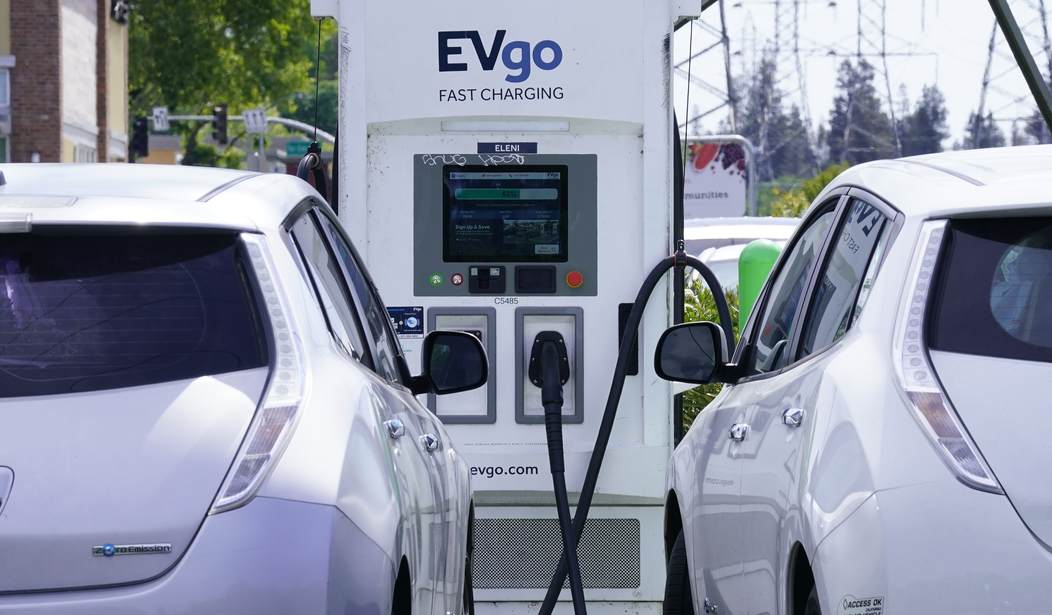Editor's Note: This column was co-authored by Jason Hayes.
Recently, the Biden administration’s Environmental Protection Agency proposed strict new tailpipe emissions standards. These standards would force fully electric vehicles to jump from 5.8 percent of new car sales in 2021 to 67 percent by 2032. The following list gives 25 reasons why the president’s lofty goals are unwarranted and would be both economically and environmentally harmful.
1. America’s electric grid already “faces a capacity shortfall … resulting in high risk of energy emergencies” when energy demand peaks in winter or summer conditions. EVs will further strain our grid unless Americans stop using electricity when we need it and reorder our lives to only use electricity when weather conditions allow it to be generated.
2. During electric capacity shortfalls, or blackouts, EVs can’t be charged. Extensive EV mandates could mean entire cities could become immobilized during blackouts.
3. Rural areas lack charging infrastructure, causing EV advocates to refer to them as “charging deserts.”
4. The large battery packs required to power EVs make them 33 percent heavier than internal combustion engine vehicles. "I am concerned about the increased risk of severe injury and death to all road users from heavier curb weights" warns U.S. National Transportation Safety Board Chair Jennifer Homendy.
5. “Thermal runaway” can cause intense and unpredictable battery fires in EVs, exposing first responders to both heat and electrical hazards. EVs in Florida experienced high-voltage electrical battery fires after their batteries were damaged by saltwater during Hurricane Ian.
6. When EV batteries burn (OR COMBUST), they are extremely difficult to extinguish. Texas firefighters used 40 times more water to douse a burning Tesla than they would have used extinguishing a regular ICE vehicle fire. One Norwegian ferry company has even banned EVs from its ships following a fire risk assessment.
Recommended
7. Charging stations can also represent an increased fire risk unless homeowners install new, dedicated circuits as “older home wiring may not be suitable” for EV charging.
8. Battery packs on electric vehicles may not be repairable if they are damaged during an accident. “For many [EVs] there is no way to repair or assess even slightly damaged battery packs,” according to Reuters.
9. EV battery ranges vary but are generally inconveniently short. Actual ranges average 12.5 percent worse than listed on price stickers, while ICE vehicles averaged 4 percent better.
10. Expected travel ranges and drivability drop significantly in winter, which could leave drivers stranded in the cold.
11. Reported travel ranges are far shorter in the summer when temperatures climb above 86°F.
12. Travel range expectations drop fast if you use accessories like air conditioning, heat or the radio.
13. EV batteries are expected to last 10-20 years in a perfect climate. But hotter climates and fast charging can overheat the battery and can reduce life expectancy significantly. Battery replacement costs range from $5,000 to $20,000.
14. Expected travel ranges drop by as much as 70 percent if you use an EV to tow a trailer.
15. In June 2022, there were almost 1.5 million registered EVs and about 130,000 charging stations around the country. It takes 7 to 10 hours to fully charge many EVs using a Level 2 charger. Expect extended wait times for a full charge.
16. About 75 percent of Americans are either unsure or view EVs as impractical, and as many as 18 percent of EV owners switch back to gasoline cars due to a lack of reliable charging.
17. Owners don’t appear to fully trust their EVs, as 78 percent of EV owners have a second gas-powered vehicle.
18. China dominates the supply chains of many critical minerals needed for EV battery manufacturing. Given the Biden Administration’s refusal to permit domestic mines, transitioning to EVs leaves U.S. transportation at the mercy of Chinese suppliers.
19. Worldwide supplies of critical minerals are currently insufficient to meet green demands. “A Dutch government-sponsored study concluded that the Netherlands’ green ambitions alone would consume a major share of global minerals.”
20. Child labor, hazardous working conditions, and lax environmental regulations plague the mining of critical minerals such as cobalt in countries like the Democratic Republic of the Congo.
21. Production of lithium for EV batteries has substantial environmental impacts. Massive mining operations threaten sensitive high desert areas in South America where it takes over 580,000 gallons of water to produce one ton of lithium.
22. Recycling options are still limited and expensive for EV batteries. Many of the materials in EV batteries cannot be economically recycled, which means they will be landfilled, or mandated recycling will push battery prices higher.
23. The International Energy Agency notes that, throughout its life, an EV will emit about half the CO2 emissions of an ICE vehicle. But while governments offer many thousands of dollars in subsidies and credits, economist Bjorn Lomborg points out that purchasing the other 50 percent in CO2 credits would cost as little as $300.
24. Even with lavish subsidies, EVs are not a cost-effective option for most Americans. The average price for an EV in 2022 was over $65,000. The average price for an ICE vehicle was $48,000. Ratcheting subsidies even higher will only mean middle class taxpayers pay higher taxes to subsidize EVs for wealthier buyers.
25. The main selling point for EVs is their claimed ability to reduce CO2 emissions from vehicle traffic. However, recent Heritage Foundation modeling demonstrated that “eliminating all U.S. [GHG] emissions would reduce global temperatures by less than 0.2° Celsius by 2100.” China builds about two new coal plants per week. So, any alleged climate benefits associated with imposing “a massive, 100-year change to the U.S. industrial base and the way Americans drive” will be rapidly eclipsed by growing emissions in the Far East.
Just 4 in ten car shoppers say they would consider switching to an EV, according to University of Chicago polling. “Only 19% of U.S. adults say it’s ‘very’ or ‘extremely’ likely they would purchase an electric vehicle.” Business and government appear happy to partner to force the American consumer to accept products they have not requested. Before attempting to force the other 81 percent of American consumers to purchase an EV, auto manufacturers should heed the thoughts of an auto industry giant.
In his 1926 book, Today and Tomorrow, Henry Ford cautioned that, when establishing a new industry, “no tractor, no thresher, no motor car, no locomotive, no new industrial device has ever been developed unless the people paid the expense. Business grows big,” reminded Ford, “by public demand. But it never gets bigger than the demand.” Ford concluded that it isn’t possible to “control or force the demand.” He argued that “there is no super-control save that of the people reacting to the service they get.”
Why are auto manufacturers and government rushing to mandate this change if consumers haven’t demanded it, economics doesn’t justify it, our $31.74 trillion national debt can’t afford it, and the environmental benefits aren’t worth it?

























Join the conversation as a VIP Member